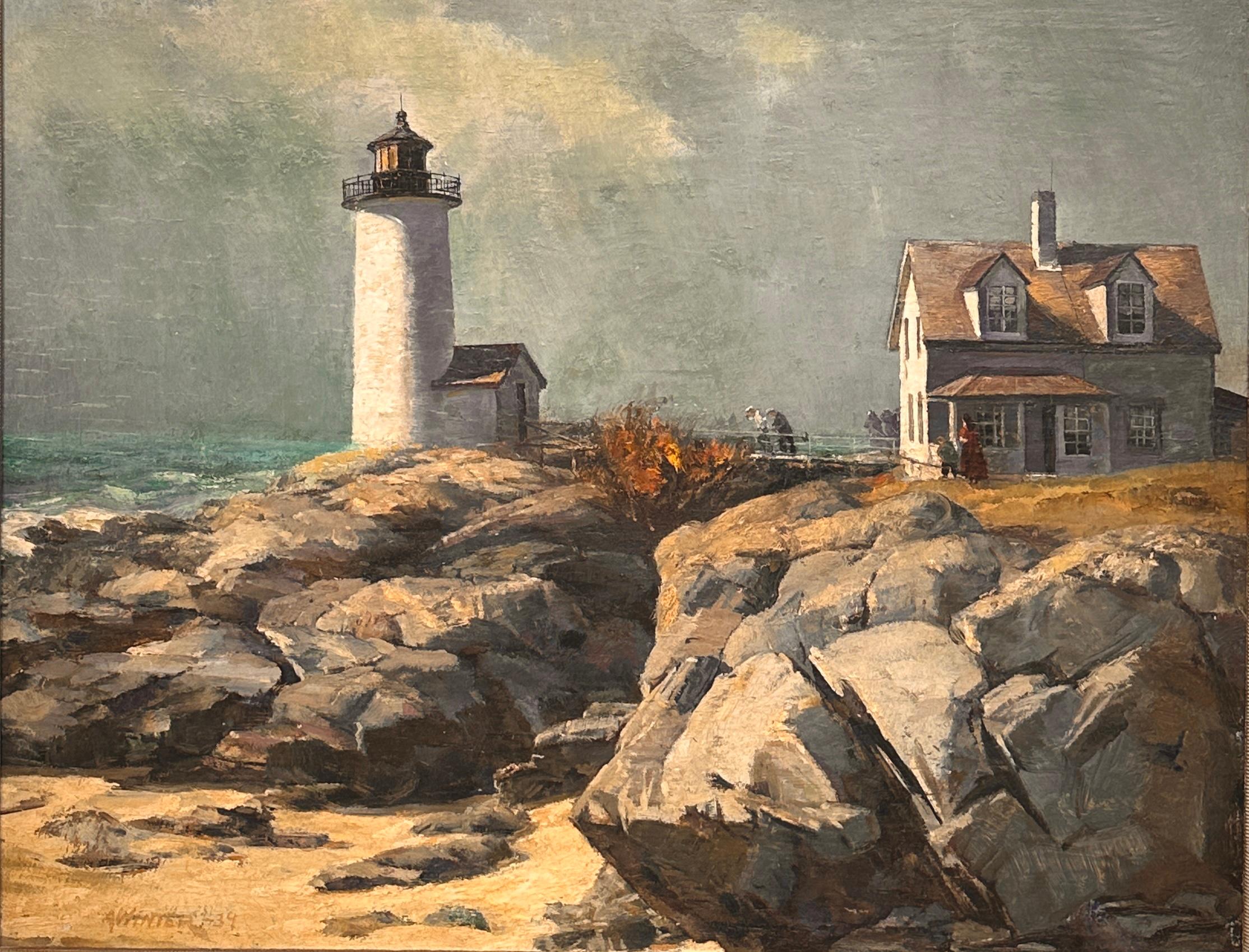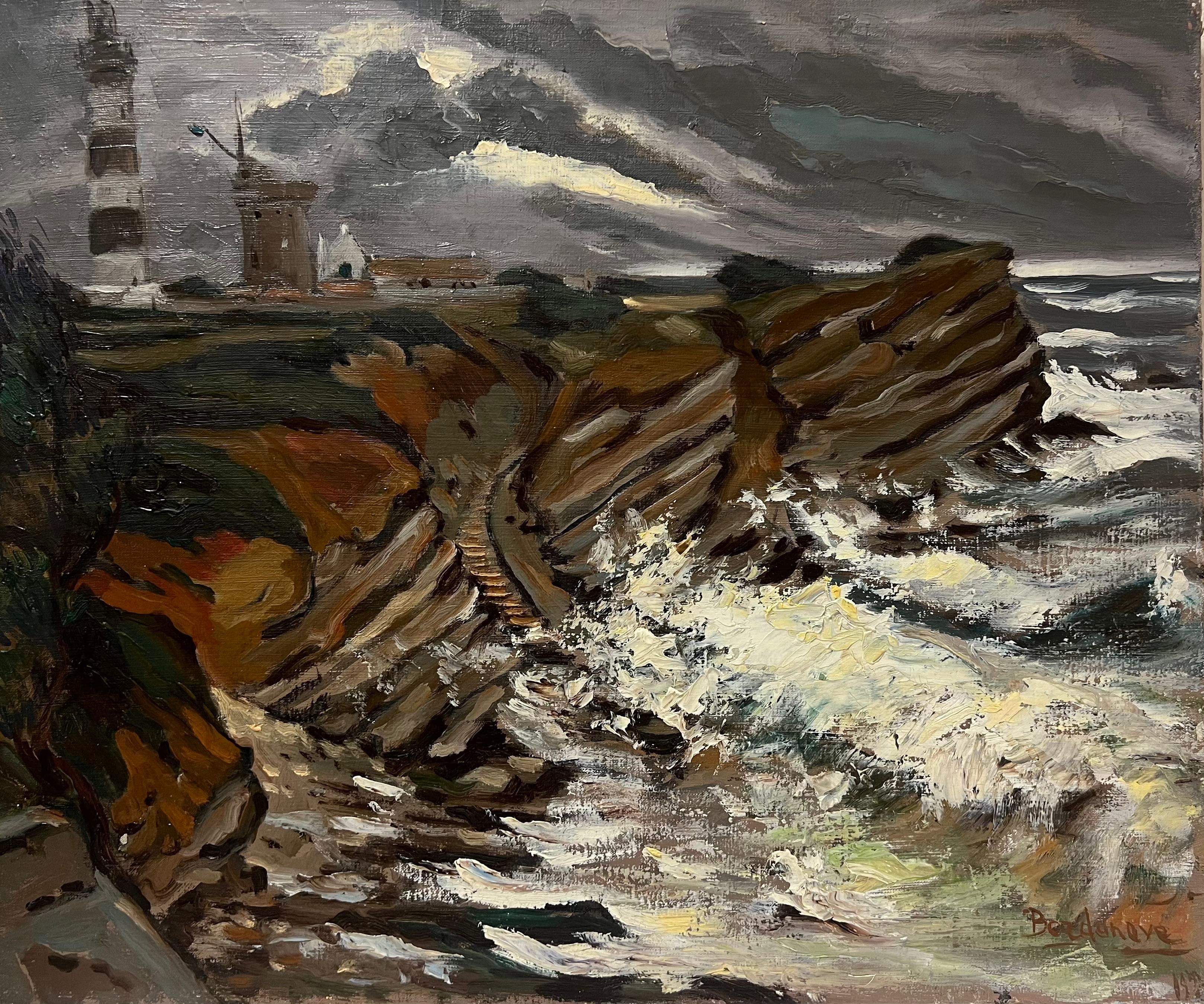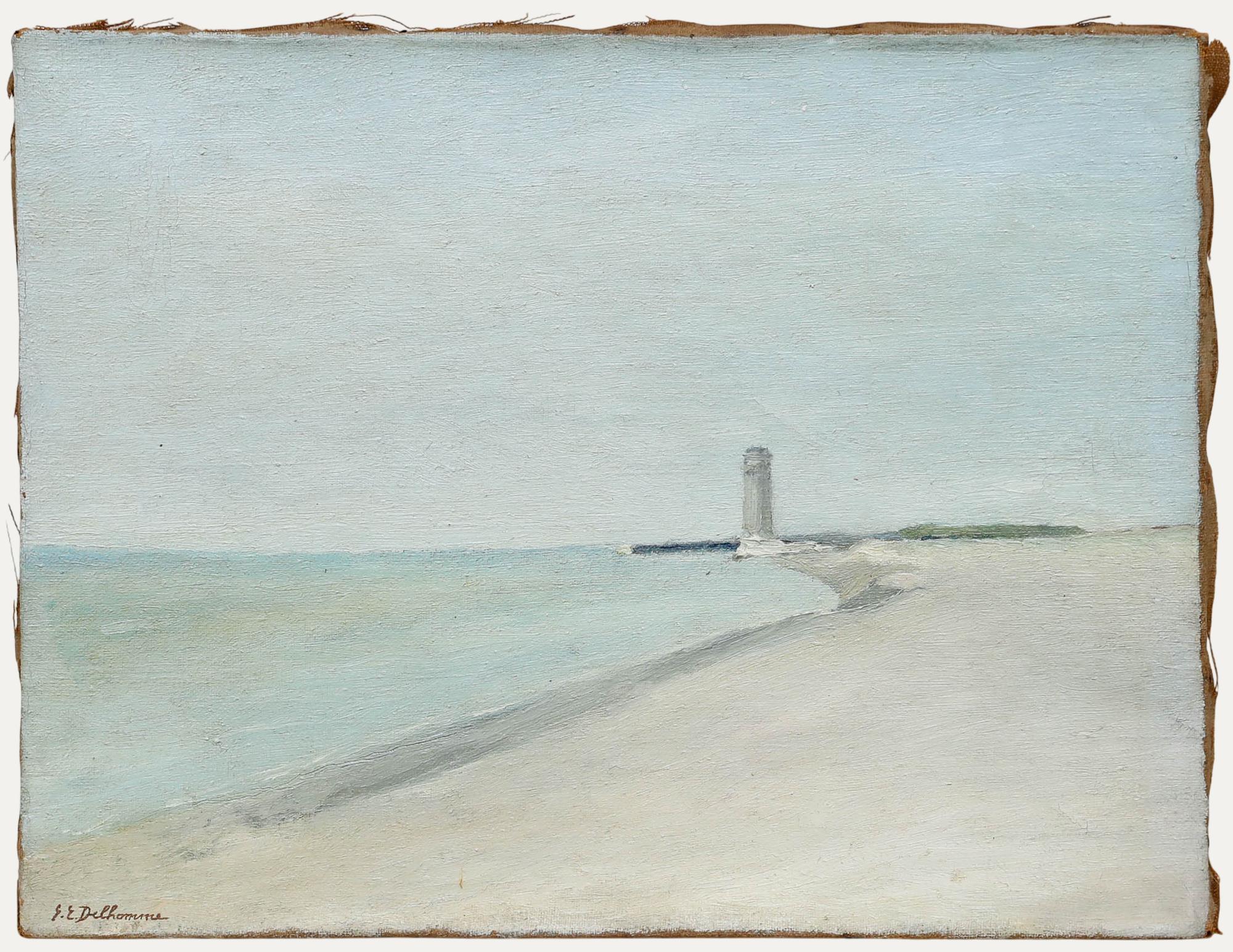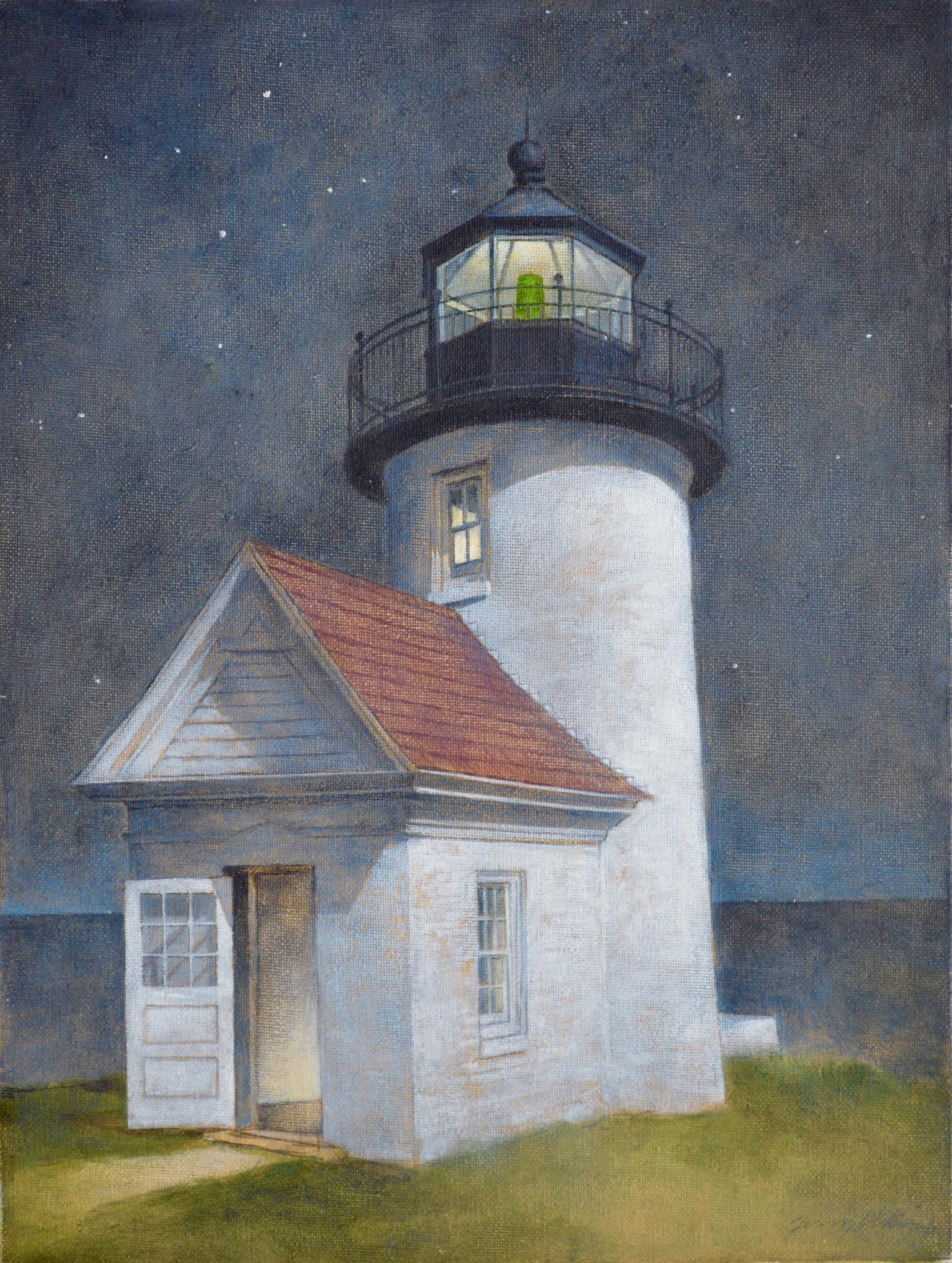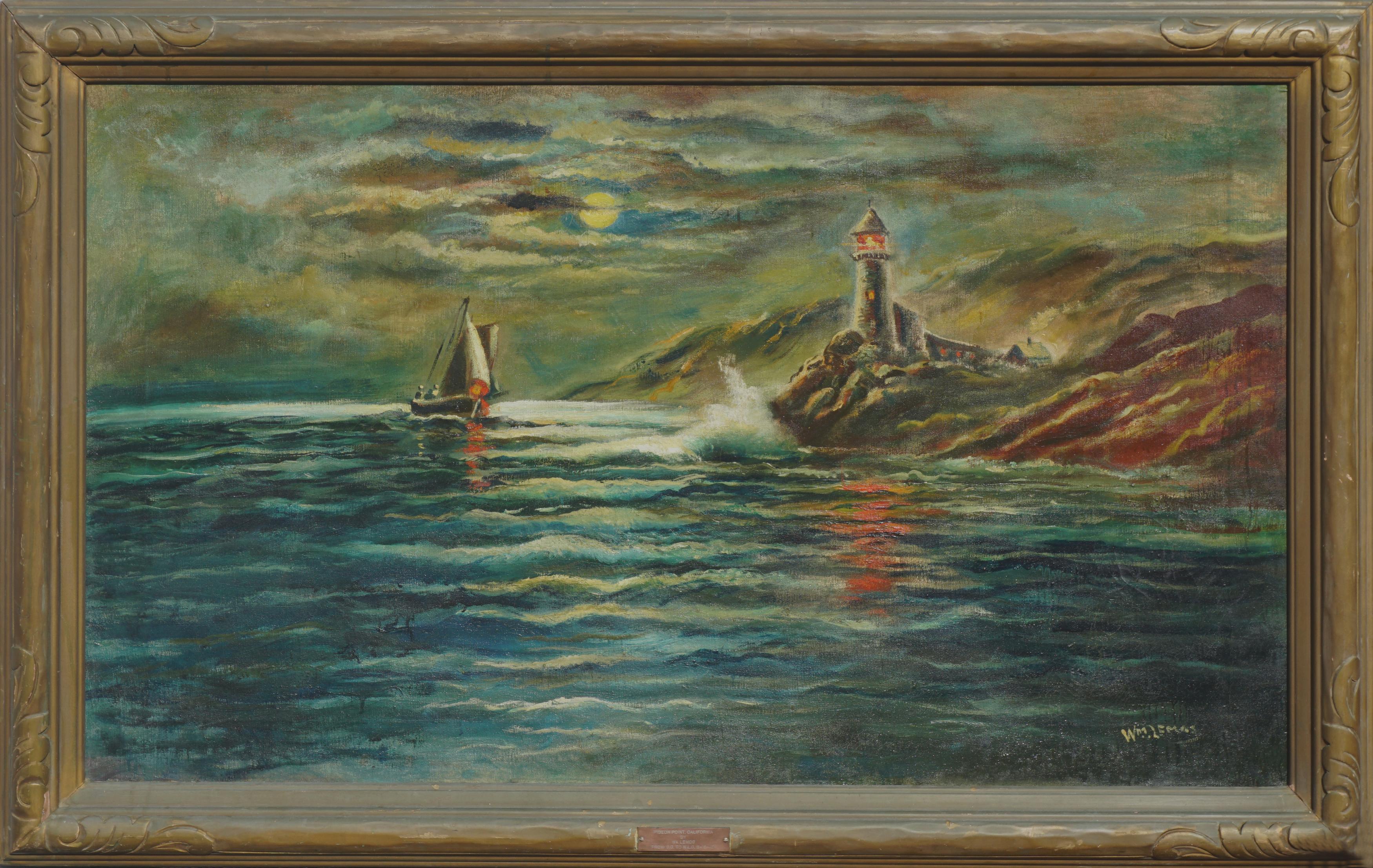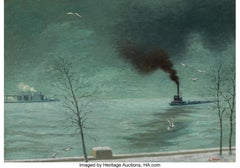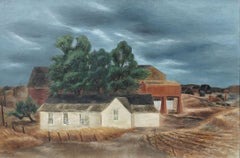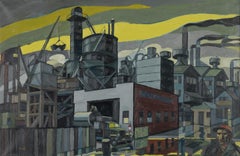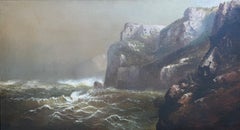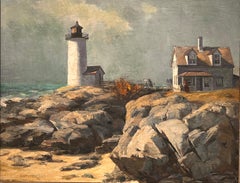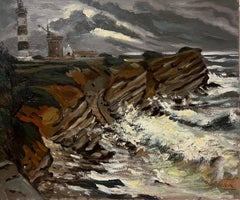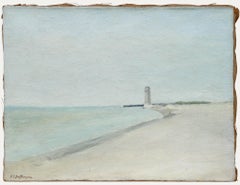Items Similar to "Motion, " Victor Arnautoff, San Francisco Lighthouse, World's Fair WPA Painting
Want more images or videos?
Request additional images or videos from the seller
1 of 11
Victor Michail Arnautoff"Motion, " Victor Arnautoff, San Francisco Lighthouse, World's Fair WPA Painting1939
1939
$60,000
$75,00020% Off
£45,309.60
£56,63720% Off
€51,875.32
€64,844.1520% Off
CA$84,735.68
CA$105,919.6120% Off
A$92,511.08
A$115,638.8520% Off
CHF 48,499.78
CHF 60,624.7220% Off
MX$1,123,582.73
MX$1,404,478.4220% Off
NOK 605,683.24
NOK 757,104.0520% Off
SEK 571,926.48
SEK 714,908.1120% Off
DKK 387,194.04
DKK 483,992.5520% Off
About the Item
Victor Mikhail Arnautoff (1896 - 1979)
Motion (Mile Rocks Lighthouse), San Francisco, 1939
Oil and tempera on board
60 x 40 inches
Signed lower left
Provenance:
The artist
California School of Fine Arts (CFSA)
John & Lynne Bolen Fine Arts, Huntington Beach, California
Exhibited:
New York, World's Fair, Exhibition of Contemporary American Art, 1939.
San Francisco Museum of Art, 1962.
Literature:
American Art from the New York World's Fair 1939, Poughkeepsie, 1987, no. 11, p. 41, illustrated.
Robert W. Cherny, Victor Arnautoff and the Politics of Art, Urbana, Illinois, 2017.
The lighthouse in the distance is the Mile Rocks Lighthouse in San Francisco Bay, built in 1906 after many shipwrecks made the lighthouse necessary. In 1962 the lighthouse was reduced in size to make room for a helipad.
Arnautoff was the son of a Russian Orthodox priest. He showed a talent for art from an early age and hoped to study art after graduating from the gymnasium in Mariupol. With the outbreak of World War I, he enrolled in the Yelizavetgrad Cavalry School. He went on to hold military leadership positions in the army of Nicholas II and the White Siberian army. With the defeat of the Whites in Siberia, he crossed into northeastern China and surrendered his weapons. Arnautoff remained in China for five years. He again tried to pursue art, but was impoverished and took a position training the cavalry of the warlord Zhang Zuolin. He met and married Lydia Blonsky and they had two sons, Michael and Vasily.
In November 1925 Arnautoff went to San Francisco on a student visa to study at the California School of Fine Arts. There he studied sculpture with Edgar Walter and painting with several instructors. His wife and children joined him, and they all continued to Mexico in 1929, where, on Ralph Stackpole's recommendation, Arnautoff took up a position as muralist Diego Rivera's assistant. Rivera and Arnautoff first worked on a series of murals at the Palace of Cortés, Cuernavaca. After starting the murals in the National Palace, Rivera went to San Francisco to paint a mural in the new Stock Exchange building, leaving Arnautoff in charge for a time. A third son, Jacob, was born in Mexico.
In 1931, the family returned to San Francisco, and Arnautoff completed his first mural commission for the Palo Alto Medical Clinic in Palo Alto (where he had been a patient) in 1932. The unveiling of this mural caused a traffic jam and some controversy, in part because the mural showed a doctor examining a female patient whose bare breasts were at eye-level. Like his other works in the Bay Area, the murals were frescoes.
In 1934 Arnautoff was chosen to execute one of the murals at Coit Tower in San Francisco, with funding from the Public Works of Art Project. He was also appointed technical director of the Coit Tower murals project. His work is prominently represented there by a mural depicting San Francisco city life. This mural includes a self-portrait as well as a portrait of his son, Michael. This mural too caused some controversy at the time, because the newsstand Arnautoff portrayed excluded the conservative San Francisco Chronicle yet included left-wing newspapers. It also included other references to the "lack of concern" people show each other, including a sign for Charlie Chaplin's "City Lights", which is concerned in part with the same theme.
Arnautoff was perhaps the most prolific muralist in San Francisco in the 1930s, completing not only the murals at the Palo Alto Clinic and Coit Tower, but also at the Presidio chapel, George Washington High School (which depicted slavery and a dead Native American), and the California School of Fine Arts library. All of these murals were focused on humanist themes, including concerns about class, labor, and power. He also painted five post offices (College Station, TX; Linden, TX; Pacific Grove, CA; Richmond, CA; and South San Francisco, CA), and held solo exhibitions throughout the 1930s.
Arnautoff taught sculpture and fresco painting privately and at the California School of Fine Arts, first during summer sessions and as a regular instructor beginning in 1936. He taught art at Stanford University from 1938 to 1962, where Richard Diebenkorn was one of his students. Beginning in 1947, he also taught art courses at the California Labor School, including printmaking.
Beginning around the time his association with Rivera, Arnautoff's political views moved to the left, and he joined the Communist Party, as well as the American Artists' Congress and the San Francisco Artists and Writers Union. His style was generally more subtle than Rivera's and other social realists, but his politics were nevertheless reflected in his work, which has been described as being part of a mural arts movement that "hoped to inspire change through criticism of the present political system". In 1955, an Arnautoff lithograph titled "DIX McSmear," associating Vice President Richard Nixon with McCarthyism, created controversy. As a result, there were calls for Stanford to dismiss him. (The lithograph was then used as the cover for an issue of The Nation.) After he was interrogated by a HUAC subcommittee, there were again calls for Stanford to dismiss him. However, the faculty committee that reviewed his case declined to make such a recommendation to the president, and Arnautoff remained a faculty member.
Following the death of his wife in 1961, Arnautoff retired from Stanford. He returned to the Soviet Union in 1963, settling in Mariupol, Ukraine, where he had attended gymnasium. While living there, he published a memoir, and created large tile mosaics on public buildings, including a school and a communications building. He also did woodcuts for books, and had several solo exhibitions. He remarried in 1970 and died in Leningrad on March 22, 1979.
- Creator:Victor Michail Arnautoff (1896 - 1979, American)
- Creation Year:1939
- Dimensions:Height: 67 in (170.18 cm)Width: 47 in (119.38 cm)
- Medium:
- Movement & Style:
- Period:
- Condition:
- Gallery Location:New York, NY
- Reference Number:1stDibs: LU184129924032
About the Seller
5.0
Platinum Seller
Premium sellers with a 4.7+ rating and 24-hour response times
Established in 2022
1stDibs seller since 2022
122 sales on 1stDibs
Typical response time: <1 hour
- ShippingRetrieving quote...Shipping from: New York, NY
- Return Policy
Authenticity Guarantee
In the unlikely event there’s an issue with an item’s authenticity, contact us within 1 year for a full refund. DetailsMoney-Back Guarantee
If your item is not as described, is damaged in transit, or does not arrive, contact us within 7 days for a full refund. Details24-Hour Cancellation
You have a 24-hour grace period in which to reconsider your purchase, with no questions asked.Vetted Professional Sellers
Our world-class sellers must adhere to strict standards for service and quality, maintaining the integrity of our listings.Price-Match Guarantee
If you find that a seller listed the same item for a lower price elsewhere, we’ll match it.Trusted Global Delivery
Our best-in-class carrier network provides specialized shipping options worldwide, including custom delivery.More From This Seller
View All"Tugboat in New York Harbor" Ernest Fiene, Modernist, Cerulean Waterscape
By Ernest Fiene
Located in New York, NY
Ernest Fiene
Tugboat in New York Harbor
Signed lower right
Oil on canvas
24 1/2 x 34 1/2 inches
Ernest Fiene was born in Elberfeld, Germany in 1894. As a teenager, Fiene immigrated...
Category
1930s American Modern Landscape Paintings
Materials
Canvas, Oil
"Glasco Landscape" Albert Heckman, circa 1940 New York Modernist Landscape
By Albert Heckman
Located in New York, NY
Albert Heckman
Glasco Landscape, circa 1940
Signed lower right
Oil on canvas
25 1/4 x 39 1/2 inches
Albert Heckman was born in Meadville, Western Pennsylvania, 1893. He went to New York City to try his hand at the art world in 1915 after graduating from high school and landing a job at the Meadville Post Office. In 1917, at the age of 24, Heckman enrolled part-time in Teachers' College, Columbia University's Fine Arts Department to begin his formal art education. He worked as a freelance ceramic and textile designer and occasionally as a lecturer at the Metropolitan Museum of Art. In the early 1920s, at the age of almost 30, he graduated with a Bachelor of Arts degree from Columbia Teachers College. He was especially impacted by his instructor at Columbia, Arthur Wesley Dow.
After graduating, he was hired by the Teachers' College as a Fine Arts instructor. He stayed with Columbia Teachers' College until 1929, when he left to attend the Leipzig Institute of Graphic Arts in Leipzig, Germany. Isami Doi (1903-1965), who was born in Hawaii, was arguably his most impressive student at Columbia. Doi is now regarded as one of the most prominent artists hailing from Hawaii. Heckman became an active member and officer of the Keramic Society and Design Guild of New York in the 1920s as part of his early commercial art career. The Society's mission was to share knowledge and showcase textile and ceramic design exhibits.
In 1922, Heckman married Florence Hardman, a concert violinist. Mrs. Heckman's concert schedule during the 1920s kept Albert and Florence Heckman apart for a significant portion of the time, but they spent what little time they had together designing and building their Woodstock, New York, summer house and grounds. A small house and an acre of surrounding land on Overlook Mountain, just behind the village of Woodstock, were purchased by Albert and Florence Heckman at the time of their marriage. Their Woodstock home, with its connections, friendships, and memories, became a central part of their lives over the years, even though they had an apartment in New York City.
Heckman's main artistic focus shifted to the house on Overlook Mountain and the nearby towns and villages, Kingston, Eddyville, and Glasco. After returning from the Leipzig Institute of Graphic Arts in 1930, Mr. Heckman joined Hunter College as an assistant professor of art. He worked there for almost thirty years, retiring in 1956. Throughout his tenure at Hunter, Mr. Heckman and his spouse spent the summers at their Woodstock residence and the winters in New York City. They were regular and well-known guests at the opera and art galleries in New York. Following his retirement in 1956, the Heckmans settled in Woodstock permanently, with occasional trips to Florida or Europe during the fall and winter. Mr. Heckman's close friends and artistic career were always connected to Woodstock or New York City. He joined the Woodstock art group early on and was greatly influenced by artists like Paul and Caroline Rohland, Emil Ganso, Yasuo Kuniyoshi, Andre Ruellan, and her husband, Jack...
Category
1940s American Modern Figurative Paintings
Materials
Canvas, Oil
"Colonial Sand and Stone Company, New York, " Industrial WPA Scene, Precisionist
By William Sharp
Located in New York, NY
William Sharp (1900 - 1961)
Factory on the River
Oil on canvas
20 1/2 x 28 1/2 inches
Initialed lower left: WS
Provenance:
Estate of the artist
Private Collection, New York
Swann Auction Galleries, American Art, June 13, 2019, Lot 178
Private Collection, New York
Colonial Sand and Stone Co., founded by Generoso Pope, was once the country’s largest sand and gravel business, providing the concrete for much of New York City’s skyline, including the Empire State Building, Rockefeller Center, Radio City Music Hall, airports and subways.
William Sharp was born on June 13, 1900, in Lemberg, Austria, where he attended college and the Academy for Arts and Industry. He later studied in Kraków, Poland, and in Berlin and Munich, Germany. Sharp began his career as a designer of stained-glass windows and as a painter of murals. He served in the German army during World War I. After the war he became a newspaper artist in Berlin and a well-known etcher.
Sharp drew political cartoons that were bitterly critical of the growing Nazi movement. As the influence of National Socialism intensified, he began to contribute drawings, under a pseudonym, to publications that were hostile to Hitler. After Hitler assumed power, Sharp was confronted with these drawings and told that he would be sent to a concentration camp. However, in 1934, he escaped to the United States.
His first newspaper assignment in America was making courtroom sketches for The New York Mirror...
Category
Mid-20th Century American Realist Landscape Paintings
Materials
Canvas, Paint, Oil
"Maine Cliffs, Rough Sea" Harrison Bird Brown, American, Rough Sea, Rocky Coast
By Harrison Bird Brown
Located in New York, NY
Harrison Bird Brown
Maine Cliffs, Rough Sea
Signed lower right
Oil on canvas
20 x 36
Provenance
Estate of John Carter, Gloucester, MA
Harrison Bird Brown was born in 1831 in Portl...
Category
1870s Naturalistic Figurative Paintings
Materials
Canvas, Oil
"Factory on the River" Modernist and Precisionist WPA Industrial New York Scene
By William Sharp
Located in New York, NY
William Sharp (1900 - 1961)
Factory on the River
Oil on canvas
17 1/2 x 23 1/4 inches
Initialed lower right: WS
Provenance:
Estate of the artist
Private Collection, New York
Swann Auction Galleries, American Art, June 13, 2019, Lot 178
William Sharp was born on June 13, 1900, in Lemberg, Austria, where he attended college and the Academy for Arts and Industry. He later studied in Kraków, Poland, and in Berlin and Munich, Germany. Sharp began his career as a designer of stained-glass windows and as a painter of murals. He served in the German army during World War I. After the war he became a newspaper artist in Berlin and a well-known etcher.
Sharp drew political cartoons that were bitterly critical of the growing Nazi movement. As the influence of National Socialism intensified, he began to contribute drawings, under a pseudonym, to publications that were hostile to Hitler. After Hitler assumed power, Sharp was confronted with these drawings and told that he would be sent to a concentration camp. However, in 1934, he escaped to the United States.
His first newspaper assignment in America was making courtroom sketches for The New York Mirror...
Category
Mid-20th Century American Realist Landscape Paintings
Materials
Canvas, Paint, Oil
"Martha's Vineyard Coastline" Wesley Webber, Stormy Waters, Massachusetts Beach
By Wesley Webber
Located in New York, NY
Wesley Webber
Martha's Vineyard Coastline
Signed lower right, inscribed on stretcher
Oil on canvas
16 x 26 inches
Marine, landscape, and historical artist, Wesley Elbridge Webber w...
Category
1870s Naturalistic Figurative Paintings
Materials
Canvas, Oil
You May Also Like
Easterly Wind, Annisquam Light 1939, Coastal Seascape Scene, Lighthouse
By Andrew Winter
Located in Rockport, MA
"Easterly Wind, Annisquam Light 1939" is a captivating original landscape painting created by the renowned artist Andrew Winter. This piece exudes the be...
Category
1930s Landscape Paintings
Materials
Canvas, Oil
Large French 1970's Impressionist Oil Painting Crashing Waves Lighthouse Coast
Located in Cirencester, Gloucestershire
The Lighthouse
signed by Georges Bordonave (French contemporary)
dated 1972
oil painting on canvas, unframed
canvas: 18 x 21.75 inches
condition: very good
provenance: from a large p...
Category
Late 20th Century Impressionist Landscape Paintings
Materials
Oil
Storm Cove Lighthouse
By Nat Levy
Located in San Francisco, CA
This artwork titled "Storm Cove Lighthouse" c.1950 is a watercolor on paper by noted California artist Nat Levy 1896-1984. It is signed at the lower right corner by the artist. The a...
Category
Mid-20th Century American Impressionist Landscape Drawings and Watercolors
Materials
Watercolor
Georges Eugene Delhomme (1904-1989) - Mid 20th Century Oil, The Old Lighthouse
Located in Corsham, GB
This serene coastal landscape features a solitary lighthouse standing sentinel on a curving sandy shore, its stark vertical form contrasting with the horizontal expanse of sea and sk...
Category
20th Century Landscape Paintings
Materials
Oil
"Keeper's Concern" contemporary oil painting of classic old lighthouse
By Terry Elkins
Located in Sag Harbor, NY
"Keeper's Concern" is a contemporary oil painting of a classic old lighthouse in Northeastern United States.
Frame Dimensions 22.5 x 18.5in
After growing up in the American South and receiving his BFA from Sam Houston State University, and an MFA from the University of Houston in Texas, Terry...
Category
21st Century and Contemporary Surrealist Landscape Paintings
Materials
Canvas, Oil
Nocturnal Pigeon Point Lighthouse
By William M. Lemos
Located in Soquel, CA
Luminous painting of Pigeon Point Lighthouse, California by listed artist William M. Lemos (American, 1861-1942). Signed "W.M. Lemos" lower right, titled on verso. Presented in hand carved, rustic giltwood frame and brass title plaque. Image size: 30"H x 50"W. Framed size: 36.50"H x 56.5"W. Condition: Good. Previously owned and used, with little or no signs of wear and is in good condition. No structural issues.
Born in New York, Lemos moved to San Francisco in 1887 where he established a studio at 106 Geary Street. He later moved to Santa Cruz in 1896, where he settled, painting murals for many local businessmen and the Santa Cruz Beach Boardwalk.
As a boy Lemos earned money by wandering the streets and painting on request. Arriving in San Francisco in 1887, he established a studio at 106 Geary. With his wife Mabel, he worked in Los Angeles for a few years in the 1890s. After settling in Santa Cruz in 1896, he painted murals for many local businessmen. When the original Beach Casino was built there at the Boardwalk in 1904, Lemos was the first concessionaire and worked there for nearly 40 years. On his platform in the Casino, Lemos did paintings of redwoods, still lifes, forest fires, beach scenes, and marines. Many of his oils were done on redwood slabs which were popular with the tourists; in the early days these paintings sold for one dollar and up depending on the size of the work. After his vision failed and he was unable to paint, his last years were mostly spent fishing off the Municipal Pier with a friend who baited his hook for him because he could no longer see. In the March 27, 1941 Santa Cruz Sentinel News Lemos reminisced, "Them were the days when the Boardwalk was only twelve feet long and when business got slow I picked up my shotgun and went across the street and shot ducks where the Casa del Rey Hotel now stands." Exhibited: Calif. State Fair, 1885; Mechanics' Inst. (SF), 1889. In: Santa Cruz City Museum; Wawona Hotel (Yosemite).
Edan Hughes, "Artists in California, 1786-1940"
His mother was Julia Lemos, a Chicago artist famous for her depiction of the Chicago fire, “Two of Julia’s children became successful artists. Her eldest son, William, was a naïve still life, landscape, and mural painter. As a young boy in New York, he would wander the streets, earning money for the family, by ‘painting on request.’ At age 26, William moved to San Francisco, California. He opened an art studio and kept it running until he moved to Santa Cruz with his wife, Mabel, in 1896. During this period, he worked as a fresco artist painting ‘murals for many local businessmen.’
Exhibited California State Fair, Sacramento, 32nd annual, per Sacramento Daily Union, September 9, 1885. and article goes on to say “William Lemos and wife, Sacramento – Art school exhibits in which are shown such a variety of designs in decorative art, flower painting, and ornamentation, that one must give time to the examination.”
Exhibited Mechanics Institute, San Francisco, 1889.
“Lemos and his wife were in Fresno California 1890...
Category
Early 20th Century American Impressionist Landscape Paintings
Materials
Canvas, Oil
More Ways To Browse
New York Worlds Fair 1939
Vintage 1939 New York Worlds Fair
Vintage Worlds Fair
1939 Fair
1939 World Fair
Nicholas Ii
Bare Breasts
Hillier Parker
Holland Painting Of Boats
Hunting Scene Horse Hound
Idaho Landscape Painting
Impasto Painting Boat
Ireland Sketch
Irwin Whitaker
James Reynolds
Josep Maria Vayreda Canadell On Sale
Joshua Tree Painting
Jules Noel
